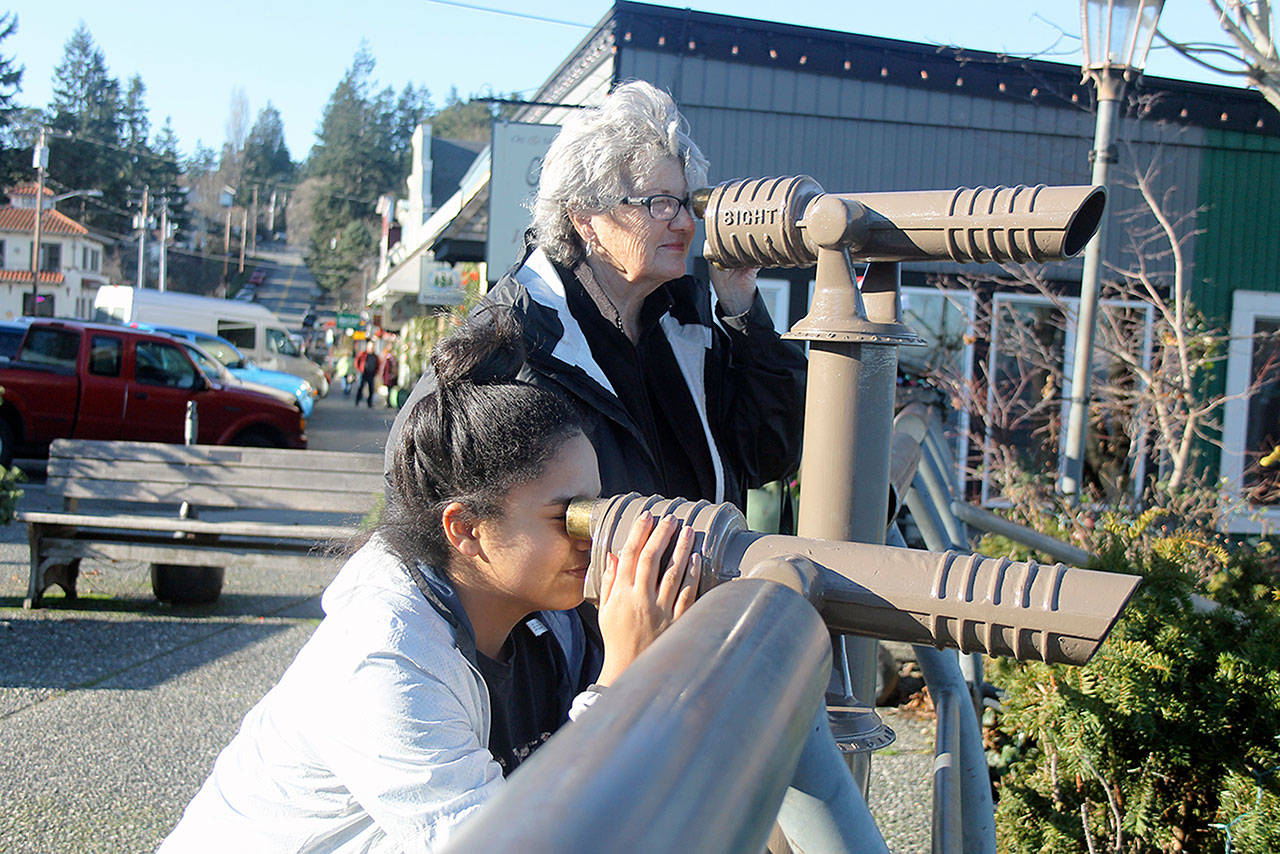It was the perfect day to do some sightseeing around Langley on Wednesday for West Seattle residents DeeDee Coghill and Alexis Berridge-Green.
And Langley’s two new pirate-style telescopes at Boy and Dog Park made the view all the more enjoyable.
The city recently installed the 20-power, 60-millimeter telescopes just off First Street for residents and tourists to get a closer look at whales, marine life, passing boat traffic and the Cascade Range. One of the telescopes has another viewfinder mounted on a single pedestal, which is bent to allow people in wheelchairs to use it in compliance with the Americans with Disabilities Act (ADA).
A third telescope will soon be installed at Whale Bell Park near Anthes Avenue.
Coghill and Berridge-Green, who were on South Whidbey visiting family, often come to Langley to shop or attend events such as Mystery Weekends. Coghill said she’d heard about the telescopes from a previous article in The Record. She and Berridge-Green wanted a look for themselves.
While temperatures were in the low 40s, the sun was out and the view across Saratoga Passage was clear.
“We were comparing it to yesterday, with all the rain,” Coghill said. “It’s perfect. It’s cold, but it’s clear and crisp. When we saw those mountains, you know (it’s) beautiful. The telescopes are powerful”
Berridge-Green didn’t expect the telescope to have such a far reach.
“It’s cool,” Berridge-Green said. “I didn’t think I could see that close into the mountains.”
The SM-1000 All Weather model telescopes, produced by Turomatic Machine Co.’s division The Glass Eye, cost $13,000. They were purchased in April using funds from the $250,000 Complete Streets grant program, as they fall under the umbrella of “aesthetic improvements,” according to Public Works Director Stan Berryman.
The telescopes took about eight months to arrive because the company was backlogged, Berryman said. City workers used lag bolts to secure the telescopes, which are built like tanks and able to withstand weather and other potential impacts, to the existing concrete deck.
Berryman said the telescopes are already making an impact.
“I see many people lining up trying to look out,” Berryman said. “I think it really enhances the experience. They’re able to see whales and boats and wildlife. It’s a good improvement.”
The telescopes were the brainchild of the Langley Main Street Association’s Economic Committee. Callahan McVay, chairman of the committee and owner of Firehouse Glass Gallery on Second Street, said it took a group effort to push the idea forward to the city council for approval. It was later submitted to the state by city staff.
McVay said that beyond the telescope’s capabilities of seeing whales, marine life and fishing boats, people can also see the Northern Lights and moonscapes at nighttime.
He said he was also happy to see the telescopes are ADA-compliant in a town with an aging population.
“The telescopes are a great addition to a seaside town,” McVay said. “Langley is looking forward to embracing its seaside culture.”
Howard Garrett, co-founder of the Langley-based Orca Network, also said the telescopes are a positive for Langley. The Southern Resident Orca population, transients and gray whales are all visible to the naked eye, but having telescopes enhances whale-watching opportunities, he said. Saratoga Passage is a main route for whales as they travel to places like Penn Cove, Holmes Harbor and a beach near Fox Spit Road in Langley.
“It just complements the whale knowledge and information that Langley is becoming known for,” Garrett said.



